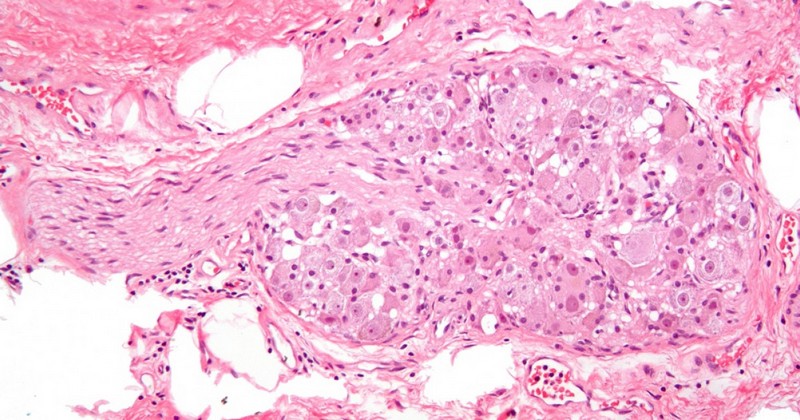Nerve ganglion: types and functions of this part of the nervous system.

This part of the peripheral nervous system is very important in driving electrical signals.
A nerve ganglion is the grouping of neuronal bodies located outside the central nervous system that performs very important functions in transporting electrical impulses connecting the brain to specific organs.
In this article we will see what a nerve ganglion is, how it is made up and what are its functions.how it is composed and what are the two main types into which it is divided.
What is a nerve ganglion?
In biology, the term "ganglion" is used to designate masses of tissue that form in cellular systems. Specifically in neurology, this term usually refers to a mass or grouping of nerve cell bodies present in most living organisms. Its main function is to carry nerve impulses from the periphery to the center, or vice versa.
In this sense, a "nerve ganglion" is the agglomeration of somas or nerve cell bodies present in most living organisms. agglomeration of somas or neuronal bodies that are located in the autonomic nervous system.. It is mainly responsible for connecting the peripheral nervous system with the central nervous system, both efferently (from the central nervous system to the sensory organs) and afferently (from the sensory organs to the central nervous system).
Therefore, a nerve ganglion is composed broadly by afferent nerve cell bodies, efferent nerve cell bodies, and neuronal axons.. Likewise, it can be divided into two major subtypes according to the specific function they perform within the peripheral nervous system.
Types of nerve ganglion
Nerve ganglia are located outside the central nervous system, i.e. in the autonomic nervous system. According to the specific part of the autonomic nervous system to which they belong, as well as according to the specific path they follow to transmit nerve impulses, these ganglia can be divided into sensory and autonomic ganglia.
1. Sensory or spinal nerve ganglion
The sensory nerve ganglion acts by receiving signals from the periphery and sending them to the brain, i.e. it has an afferent function. It is also known as somatic ganglion, sensory ganglion, or spinal ganglion, since it is located in the posterior part of other structures called spinal nerves. The latter are the nerves that shape the dorsal and ventral roots of the spinal cord.. For the same reason, the sensory nerve ganglion is also known as the spinal ganglion.
It extends along these roots or branches through different parts of the body, and is responsible for activating electrical impulses from the skin and back muscles (dorsal branches). In fact, another common name for these ganglia is "dorsal root ganglia".
2. Autonomic or vegetative nerve ganglion
The autonomic nerve ganglion acts in the opposite direction to the sensory nerve ganglion, i.e. efferently: it receives signals from the central nervous system and sends them to the periphery. It is also called vegetative ganglion, and since it belongs to the autonomic nervous system, it regulates motor activity. They are located near the viscera on which they act.The parasympathetic ganglia are divided into two types of ganglia:
2.1. parasympathetic ganglia.
These ganglia are part of the parasympathetic nervous system. They are located in the wall of the viscera they innervate, i.e. in the specific area of the organism where the nerve acts. Because of their proximity to the organs on which they act, they are also known as intramammular ganglions (except for those acting on the neck and head). They are composed of three different roots according to the path followed by the nerve fibers: motor root, sympathetic root or sensory root.
In turn, these nerve fibers form different cranial nerves, including the oculomotor, facial, glossopharyngeal, vagus and pelvic splanchnic nerves.
2.2. Sympathetic ganglia
As their name indicates, they are part of the sympathetic nervous system. They are located on both sides of the spinal cord, forming long nerve chains. These are the ganglions that are found around the celiac trunk (arterial trunk originating in the aorta, specifically in the abdominal part of this artery). The latter are the prevertebral sympathetic ganglia, and can innervate the organs that make up the abdominal and pelvic region, or else.
On the other hand, there are the paravertebral ganglia, which form the paravertebral chain and are directed from the neck to the thoracic cavity, acting especially on the viscera.
Among their main functions is the transmission of information about events that may be risky for the organism. In this sense, they are related to stress situations and constitute one of the elements responsible for responding to these, either by flight or by aggression.
Bibliographical references:
- Clínica Universidad de Navarra (2015) Nerve Ganglion. Medical Dictionary, University of Navarra. Retrieved August 20, 2018.
- Encyclopedia Britannica (2018). Ganglion. Physiology, Encyclopedia Britannica. Retrieved August 20, 2018. Available at https://www.britannica.com/science/ganglion.
- Butler, D. (2002). Mobilization of the nervous system. Editorial Paidotribo: Barcelona.
- Navarro, X. (2002) Physiology of the autonomic nervous system. Revista Neurología, 35(6): 553-562.
(Updated at Apr 13 / 2024)